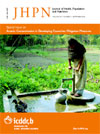
|
The Journal of Health, Population and Nutrition
icddr,b
ISSN: 1606-0997
EISSN: 1606-0997
Vol. 33, No. 2, 2015, pp. 1-10
|
 Bioline Code: hn15045
Bioline Code: hn15045
Full paper language: English
Document type: Research Article
Document available free of charge
|
|
|
The Journal of Health, Population and Nutrition, Vol. 33, No. 2, 2015, pp. 1-10
| en |
Groundwater arsenic and education attainment in Bangladesh
Murray, Michael P. & Sharmin, Raisa
Abstract
Background: Thousands of groundwater tube wells serving millions of Bangladeshis are arsenic contaminated. This
study investigates the effect of these wells on the education attainment and school attendance of youths who rely
on those wells for drinking water.
Methods: The analysis combines data from the 2006 Bangladesh Multiple Indicator Cluster Survey (2006 MICS) and
the National Hydrochemical Survey (NHS) of Bangladeshi tube wells’ contamination conducted between 1998 and
2000. The study uses multiple regression analysis to estimate the differences in education attainment and school
attendance among the following: (i) youths who live where tube wells are safe, (ii) youths who live where tube
wells are unsafe but who report drinking from an arsenic-free source, and (iii) youths who live where tube wells are
unsafe but who do not report drinking from an arsenic-free source.
Results: Controlling for other determinants of education attainment and school attendance, young Bangladeshi
males who live where tube wells are unsafe (by Bangladeshis standards) but who report drinking from arsenic-free
sources are found to have the same education attainment (among 19- to 21-year-olds) and school attendance
(among 6- to 10-year-olds), on average, as corresponding young Bangladeshi males who live where wells are safe.
But young Bangladeshi males who live where tube wells are unsafe and who do not report drinking from an
arsenic-free source attain, on average, a half-year less education (among 19- to 21-year-olds) and attend school, on
average, five to seven fewer days a year (among 6- to 10-year-olds) than do other Bagladeshi males of those ages.
The estimated effects for females are of the same sign but much smaller in magnitude.
Conclusion: Bangladeshi public health measures to shift drinking from unsafe to safe wells not only advance good
health but also increase males’ education attainment.
Keywords
Arsenic; Education; Groundwater; Bangladesh
|
| |
© Copyright 2015 - The Journal of Health, Population and Nutrition
Alternative site location: http://www.jhpn.net
|
|
